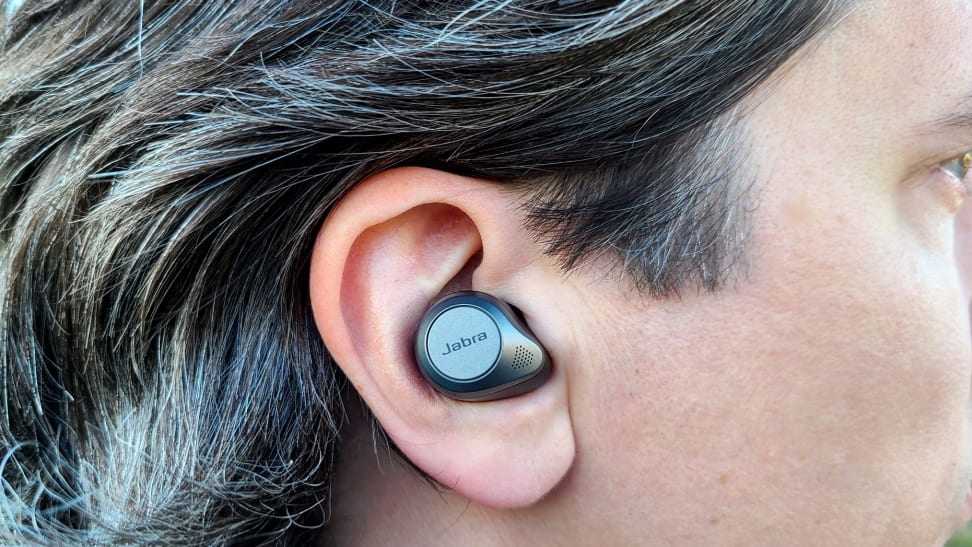 — Recommendations are independently chosen by Reviewed’s editors. Purchases you make through our links may earn us a commission.
— Recommendations are independently chosen by Reviewed’s editors. Purchases you make through our links may earn us a commission.If you're looking for the best wireless earbuds you can buy, no matter which phone you own, you want Jabra's Elite Active 85t (available at Amazon for $179.99). They provide superb build quality, audio performance, usability, and noise canceling alongside comprehensive controls (for iPhone and Android) and a wide array of other top-flight features. This adds up to the most well-rounded buds in the business.
As our sprawling list shows, however, there are a shocking amount of impressive wireless options, from Apple's indomitable AirPods Pro to options from Samsung, Sony, and others. We've tried out dozens, using both real-world and lab testing, and we're constantly testing new pairs. The rankings are extremely tight, and each pair has something to offer, so rest assured you'll find the perfect wireless earbuds below, no matter what you're into.
If you're looking for more options, check out our lists of the Best Workout Buds and the Best True Wireless Earbuds Under $100.
These are the best wireless earbuds we tested:
- Jabra Elite 85t
- Sony WF-1000XM4
- Jabra Elite Active 75t
- AirPods Pro
- Amazon Echo Buds (gen 2)
- Samsung Galaxy Buds Pro
- Sennheiser Momentum True Wireless 2
- Panasonic RZ-S500W
- Klipsch T5 II True Wireless
- Bose QuietComfort Earbuds
- Soundcore Liberty Air 2 Pro.
- Beats Studio Buds
- Samsung Galaxy Buds+
- Powerbeats Pro
- Google Pixel Buds


The Jabra Elite 85t offer the best features, usability, and controls no matter which phone you choose.
Jabra’s Elite 85t really have it all: smooth and balanced sound, impressive active noise cancellation (ANC), comprehensive controls, a compact form factor, solid battery life, and a barrel full of other top-flight features. It all adds up to the best wireless earbuds—whether you pledge your allegiance to Android or iPhone.
Perhaps more than any one feature, it’s the open-style design of these earbuds that make them our favorite all-around bombers. While a more bulbous design means the fit isn’t quite as secure as their Elite 75t predecessors, the Elite 85t's oval ear tips provide a proper seal without plugging up your ears. This means you won’t hear yourself chewing, walking, jogging, etc. in the same way as most earbuds, and yet music and noise canceling are intimate and effective respectively.
That also makes the Elite 85t direct competitors to Apple’s open-style AirPods Pro, but with more features for either side of the mobile aisle, and a more active-ready design to boot. Since they’re device agnostic, you can choose any of the major voice assistants (or none), and they offer all the controls you need (including volume control by default) for whichever mobile device you prefer—all at once.
Speaking of controls, they’re customizable through Jabra’s excellent Sound+ app, allowing you to configure the buds’ two easy-push buttons how you see fit. Also customizable are noise cancellation and transparency mode, the latter of which is among the most natural-sounding you’ll hear on the market to keep you aware of your environment in style—again, a direct shot across the AirPods Pro bow.
The word "natural" keeps coming up when using the Elite 85t, and it's a big key to their success. You can wear them for hours, even when you’re not listening to audio, and never miss a beat thanks to how seamlessly they transition between noise canceling and transparency mode; a few taps of the keys (even while wearing gloves) lets you slide between jamming out in solitude and striking up a conversation. Multi-point connection to your devices also makes it easy to switch between fun and work modes.
As for downsides, the Elite 85t’s IPX4 water resistance rating means you can splash them but not dunk them. That meets or beats nearly all direct competitors outside Jabra, but they’re not as weather-ready as their cousins, the Elite and Elite Active 75t earbuds. As referenced above, the fit is also less stable than what you’ll get in purpose-built workout buds. And finally, while you can use one bud at a time, only the right one will pull off the trick, which makes them less versatile in this use case than some competitors.
Those are all pretty minor complaints, though, as the Elite 85t really are the complete package. If you can afford their not-insignificant cost, you’ll be rewarded with good sound, great features, and the best usability on the market.
Pros
-
Outstanding features and design
-
Rich, balanced sound
-
Impressive noise canceling
Cons
-
Not as sport-friendly as other Jabra buds
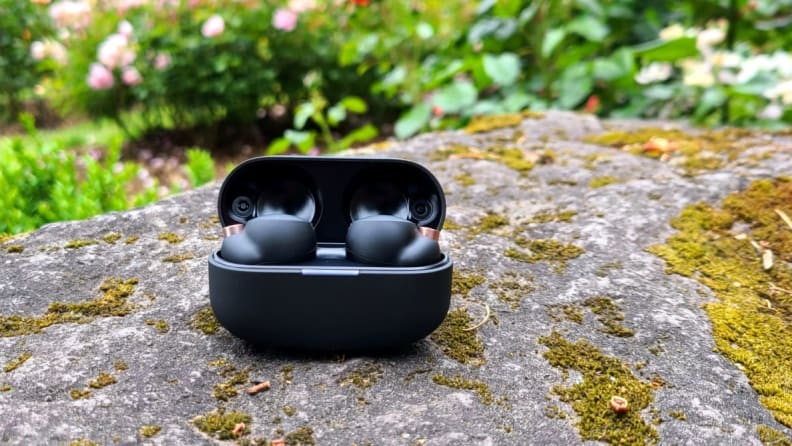

The Sony WF-1000XM4 offer brilliant sound, incredible noise canceling, and other premium features to make them amongst the best buds you can buy.
Sony waited two years for a follow-up to its flagship noise canceling earbuds, but it was worth our patience. While the WF-1000XM3 are still a fantastic pair of earbuds for the money, the new WF-1000XM4 (not to be confused with the WH-1000XM4 over-ears) take things up to a whole new level. Blending incredible sound quality, innovative design, IPX4 waterproofing (finally), and noise canceling that puts nearly all other choices to shame, these are an expensive, but excellent choice.
There’s only one pair of earbuds you’ll find that compares to the XM4's noise canceling at time of publication: Bose’s well-regarded Quietcomfort Buds. Both pairs have their pros and cons, but the XM4 make outrank their rivals thanks to their smaller profile, next-gen battery life of up to 8 hours with active noise canceling (ANC) and a whopping 12 hours without it, and of course, their lovely, luscious sound.
It’s worth saying a bit more about that sound, as it’s among the best you’ll find in the genre. It’s sweet, smooth, accessible, and yet riddled with detail. And thanks to the stark canvas provided by the powerful noise canceling, it’s all the easier to enjoy. You’ll find tranquility with these earbuds on a level that’s hard to find with any headphones, let alone tiny earbuds.
The headphones also have plenty of features in concert with Sony’s Headphones Connect app, which lets you tweak the EQ to your heart’s content (from ramping up the bass to cycling through a dozen presets), tinker with multiple other settings, and even set the earbuds to rotate between noise canceling and ambient audio based on your routines and locations.
Their design includes comfy foam tips for a stable seal alongside intuitive touch controls, though it’s there where we’ll raise our primary complaint: the XM4 don’t allow you to use volume controls without giving up other integral functionality. In addition, they miss a few extras like Find My Earbuds and multi-point pairing, both features we’d like to see in this price range.
But if you’re looking for the best all-around noise canceling earbuds that are also some of the best earbuds, period, look no further. Sony’s WF-1000XM4 set a new bar. If you’re after a more affordable pair of Sony noise cancelers (and you don’t need water resistance), Sony’s WF-1000XM3 are still a great buy as well.
Pros
-
Fantastic noise canceling
-
Superb sound
-
Next-gen battery life
Cons
-
No viable solution for volume control
-
Missing some key features
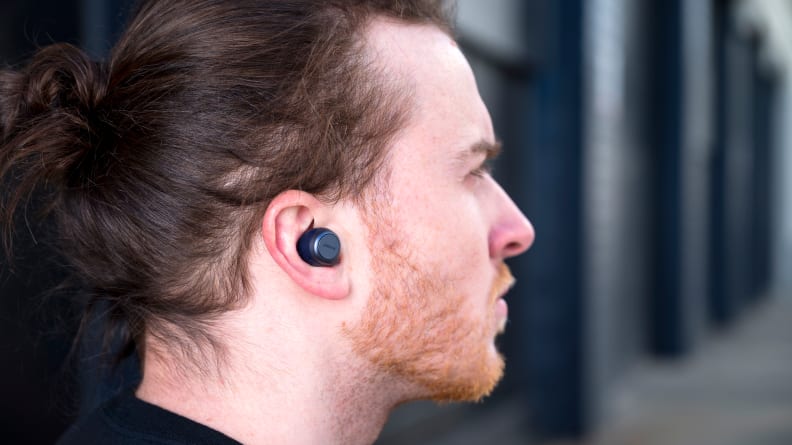

The Jabra Elite Active 75t are great for working out, and so much more.
The Jabra Elite Active 75t are a great set of wireless earphones for just about anyone. But they're particularly suitable for folks who spend a lot of time running or working out, thanks to their nimble design and their hearty, IP57-rated dust and water resistance, allowing you to safely rinse them off after a workout. (Tip: If you're looking for more like these, we have plenty to recommend in our Best Workout Headphones guide.)
The Elite Active 75t will net you nearly every bell and whistle you might need. You'll get everything from a finder function so you won't lose track of them to transparency mode, which allows you to hear the world around you so you can stay aware in nearly any situation. Jabra even released a firmware update that adds digital active noise cancellation to the impressive passive noise isolation, which helps make these already versatile buds all the more so.
The Elite Active 75t sound good, though their heavy, bass-forward sound signature won't be for everyone, and it might take some tinkering in the accompanying app to find an equalization setting that fits your playlist. Still, their sound performance will satisfy most casual listeners and power users alike, and it's bolstered by around 7 hours of battery life per charge (or around 5.5 hours with ANC).
We also love the Elite Active 75t’s playback controls; their buttons are easy enough to press without needing much force, yet firm enough that they rarely get pressed accidentally. Jabra’s intuitive controls and customization (thanks to the loaded Jabra Sound+ app) make for one of the best user experiences in the true wireless game.
One small point of caution: Their small size and rigid plastic design isn't a perfect fit for everyone, and they also may wear on those with smaller ears after a few hours—though that's the case with the majority of true wireless earbuds to some degree.
All in all, the Jabra Elite Active 75t are a great pick for folks looking for superb performance, durability, and a well-rounded experience. In addition, if you don't see the need for your earbuds to be fully submerged in water—and you want to save a few bucks—the Elite 75t earbuds are nearly identical to their cousins, only with a less-rugged IP55 dust/water-resistance rating.
Either way, you'll be getting a great pair of durable earbuds, armed for virtually any scenario you can throw at them.
Pros
-
Durable, dunkable design
-
Sleek and small
-
Loaded with features
Cons
-
Sound lacks balance
-
Fit may be tricky for some


The Apple AirPods Pro are an unstoppable force, especially if you own an iPhone.
Apple's AirPods Pro take everything we love about the traditional AirPods and ramp things up a notch (or three). They sound better than all Apple earbuds before them, deliver excellent noise reduction, and add proper water-resistance (finally). What’s more, these are the first Apple earbuds with swappable silicone ear tips, making it easy for just about anyone to get a comfortable fit.
While battery life is middling at 4.5 to 5 hours (Jabra's Elite 85t offer up to 7 hours without noise canceling), the pocket-friendly charging case holds multiple recharges for 24 hours total listening time. In addition, quick charging provides an hour of listening in just five minutes, so you'll rarely need to worry about dead earbuds.
In our lab tests, we found the AirPods Pro’s noise cancellation was on par with pricier noise-canceling headphones, with a minimal hit to battery life. Their Transparency Mode is also among the most effective and natural-sounding we’ve experienced, allowing you to pipe in the outside world for those times you want to be aware of your surroundings. The call quality—which uses dual microphones plus digital distortion reduction—is also excellent. The design also makes them incredibly easy to pair, control, and wear, particularly with Apple iPhones, which will automatically pair right out of the box.
If there's a downside to their feature set it's that most extra features like spatial audio, auto-pairing, and Siri on demand only work with iPhones, as there's no dedicated app for Android users to tap into. They also don't offer onboard volume control, requiring you to ask Siri for help instead.
That said, while the AirPods Pro are pricey, they offer enough of a meaningful upgrade that they’re worth it—especially for those who use iPhones. They can be your go-to headphones for everyday use, long trips by train or plane, and even light workouts. It's for all these reasons the AirPods Pro are some of the most popular earbuds on the planet.
Pros
-
Active noise cancellation
-
Silicon tips ensure a more comfortable fit
-
Easy setup and syncing
Cons
-
Sub-par audio quality for the price
-
No onboard volume controls
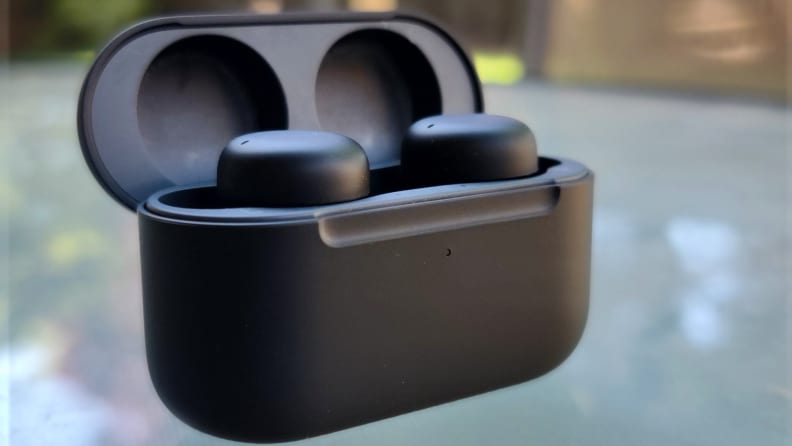

The Amazon Echo Buds offer a truckload of features at a surprisingly low price point to make them an incredible value.
Amazon’s second attempt at true wireless earbuds is a game-changer. The tech giant found a way to revamp the new Echo Buds’ blueprint, improve both their sound and features, and add true active noise cancellation. The best part? Even with all of these added perks, the second-generation Echo Buds cost exactly the same as the originals.
True wireless earbuds are all about usability. Amazon’s first earbuds didn’t pass the test there due to their bulky size and uncomfortable fit. With round two, Amazon made the Echo Buds 20% smaller and far comfier. The seal in your ears is tight, which helps for cutting out noise around you and jostling movements like running or going to the gym. On the flip side, they’re comfortable enough to avoid substantial ear fatigue after long periods of listening.
Aside from a smaller design, the implementation of full active noise cancellation is perhaps the new Echo Buds’ standout feature. The noise cancellation found in these buds may not be on par with higher end options like the Jabra’s Elite 85t, and certainly can't match up against Sony's WF-1000XM4. But for their price point, they are very effective. It’s a significant step up from the Active Noise Reduction found in the first Echo Buds. And frankly, it’s some of the best noise cancellation you can get in anything approaching their price point.
Like the originals, the battery life of the second generation Echo Buds, at just 5 hours with ANC and 6.5 hours without, isn’t anything to write home about. And there aren't a lot of customization options when it comes to sound quality. Besides that, though, Amazon’s second-gen Echo Buds are a workhorse pair of earbuds that provide a compelling combination of comfort, features, and sound quality. The combinatino makes Amazon’s Echo Buds easily among the most value-packed buds we’ve tested. And that’s without mentioning the world’s favorite voice assistant, which is of course a built-in, ready-to-help feature that puts the “Alexa” in “Alexa, turn up the volume.”
Pros
-
Revamped, comfortable design
-
Deep feature lineup
-
Impressive ANC
Cons
-
Average battery at best
-
Limited sound customization
How We Tested
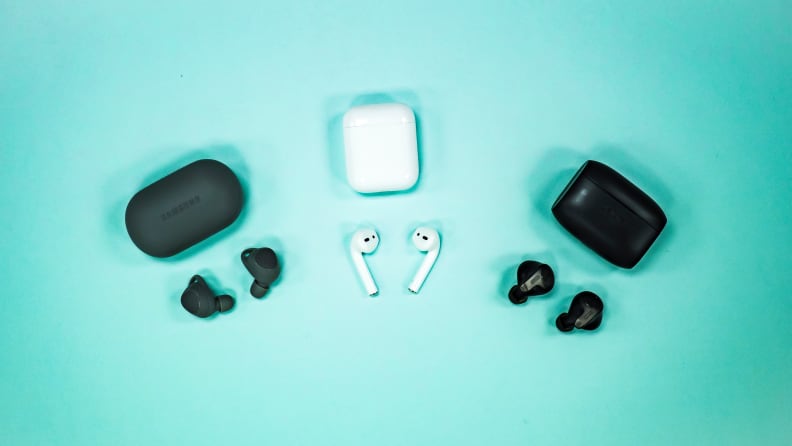
True wireless earbuds all come with two individual buds—no wires between them—and a charging case.
For this list, we focus on several key pain points that consumers typically run into when buying both wireless and “true wireless” earbuds (those completely free of any wires): battery life, ease of use, controls, wireless range, sound quality, sound isolation, and comfort.
For sound quality tests, we put our earbuds through some basic audio tests in our labs in Cambridge, MA to give us data on a few things such as max volume, passive and active noise attenuation (including active noise cancellation), and how well each earbud blocked outside noise. From there, we use all the earbuds extensively, playing a wide variety of test tracks ranging from classical to hip-hop, rock, jazz, and more.
The other features are all tested in real-life situations, including sweat proofing, short- and long-term comfort, battery life, microphone quality, and connectivity over distances and through obstacles like doors and walls.
Perhaps the biggest missing link in all headphone reviews is durability. It's simply impossible for us to test a single pair and come to a meaningful conclusion about how well they'll hold up over time and with regular use (and abuse). To account for this, we noted any major issues that popped up in user reviews (where available), though this didn't impact the final scoring. We also use these earbuds over a prolonged period and update their firmware when available to test out the latest features and update relevant articles and reviews with our findings.
The truth is that wireless earbuds across the board have struggled with durability, so this is a major cause of concern for us. Since some of these models are quite new, we are reserving the right to re-evaluate our conclusions as we become aware of any major issues or pain points as time goes on.
What You Should Know About Buying Headphones
You've probably seen a bunch of different headphones in your everyday life. While they have a number of different selling points, headphones are primarily categorized into three types: in-ear (including all earbuds), on-ear, and over-ear. For this article we'll be focused only on in-ear models. These are primarily designed to be inserted into your ear canal and, apart from audiophile options or professional in-ear monitors, the vast majority will connect to your source device wirelessly.
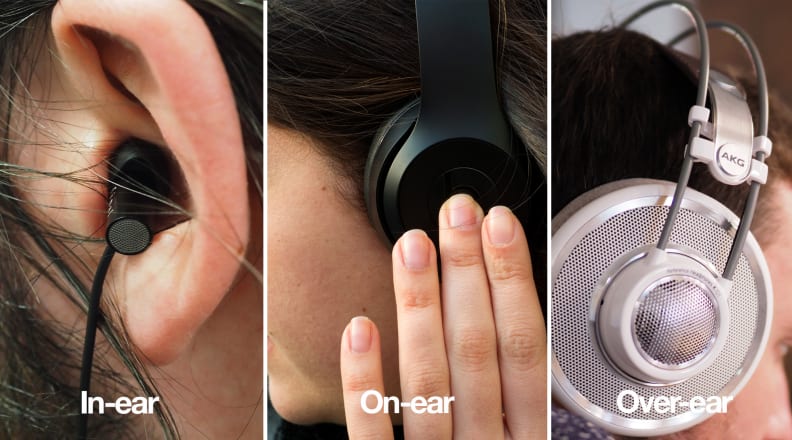
Three popular types of headphones: in-ear, on-ear, and over-ear.
Knowing the basic terminology of modern headphones is the best way to estimate what you need, which will guide you toward deciding on where you may want to compromise to fit your budget. Below are a few important terms to know before you shop.
Bluetooth/wireless: Do you want wireless headphones? A pair of Bluetooth headphones will let you unplug from your source device, while a set of "true wireless" earbuds are even more minimalist, offering totally wire-free listening with no cable between the earbuds. If you're looking for an experience that won't tether you to your phone, tablet, or laptop, Bluetooth headphones are what you need—and fortunately, they're ubiquitous enough these days that you can find them in every style and price range.
Active Noise Cancellation: Noise-canceling headphones, i.e those with active noise cancellation (ANC) aren't just for frequent flyers. Originally developed for pilots, these headphones reduce the volume of ambient noise around you. Over the last several years they've become a mainstay for travelers, public transit commuters, gym-goers, and those working in distracting environments in the office or at home. Most of our top picks include ANC as the feature has become more popular.You can also check out our guide of the best noise-canceling headphones we've tested.
Transparency mode: This feature goes by many names, including hear through mode, ambient sound mode, etc. All of these phrases refer to the same technology, which uses tiny microphones on the exterior of your headphones or earbuds to filter in sound from your environment. The purpose is to keep you aware of your surroundings, letting you play tunes while you jog or hike, while still being aware of dangers or alerts. Not all transparency mode is created equal, though, and how a headphone’s hardware and software handle things like wind gusts can make a serious difference in the feature’s utility.
IP: You'll encounter an "IP" rating across a wide array of electronics but the term is perhaps most important (in the headphone world anyway) when it comes to products designed to take on the elements. You'll often see the code "IPX" with a number at the end, or you may see codes like IP67, etc. The first number is dust resistance—essentially how well the product stands up to ingress, and the higher the number the better. The second number is water resistance. The highest you'll likely see for headphones is "7" which means the product is certified to withstand being fully submerged in one meter of water (freshwater only) for 30 minutes. For headphones, anything from IPX4 (meaning the headphones can withstand splashes from any direction) and above should do the trick. You can find more info in our IP guide.
Other Wireless Earbuds We Tested


Samsung’s Galaxy Buds Pro represent Samsung's obvious attempt to create a pair of earbuds just as special and impressive for Samsung phones as Apple’s AirPods Pro are for iPhones. And the gambit worked pretty dang well. Samsung has loaded up a feature-packed pair of earbuds bespoke for the Samsung faithful that offer plenty for those outside the Samsung family, too.
The big headliner for these earbuds is solid active noise cancellation, a first for Samsung’s true wireless buds if you don’t count the Galaxy Buds Live (and with ANC that light you probably shouldn’t). But that’s just the beginning. They also offer adjustable ambient audio, which is boostable for super hearing, alongside a truckload of other popular features we expect in flagship earbuds, from the ability to use one bud at a time to a wireless charging case and a Find My Earbuds function.
One particularly interesting feature is Voice detect, designed to pause ANC and engage ambient mode when you speak so you can keep in touch with those around you hands-free, though we found it can be overzealous at times.
Most of the Galaxy Buds Pro’s top features will work for any phone once you download Samsung’s well-equipped Wear app. But Samsung also saved a litany of extra features for the Samsung faithful, including auto-pairing, Bixby wakeup, and even a new 3D audio feature that’s saved for those with the Galaxy S21 and up. In other words, it pays to be heavily invested in Samsung’s ecosystem here.
Samsung does well to straddle both sides of that line, though, adding design traits everyone can enjoy such as class-leading water resistance (IPX7) and impressive, well-balanced sound that’s as good at bumping beats as it is carving out ultra-clear detail or serving up phone calls.
There are some downsides, including a fit that can wear on the ears over time (and can jostle during some activities), and battery life that’s just so-so for 2021 (less than 5 hours per charge with ANC). In addition, so far we’ve found the case doesn’t charge the earbuds as quickly as advertised, meaning you’ll have to wait longer once you lose juice.
That said, Samsung has created a winner here thanks to a well-rounded feature list, impressive audio performance, and a great price that make its Galaxy Buds Pro instant contenders—especially if you’re toting around a new Samsung phone.
Pros
-
Powerful, nuanced sound
-
Plenty of features
-
Stylish, micro-sized design
Cons
-
Battery life just OK
-
Sluggish charging
-
Touchy controls


If judged by sound alone, Sennheiser’s second-gen Momentum, the Momentum 2 True Wireless would be our top pick. They offer the best sound in the category, and though their amazing performance comes with a hefty price tag, they can often be found on sale for a more reasonable price point.
First, the good stuff: The Momentum True Wireless 2 serve up a rich, dynamic listening experience regardless of genre, thanks in part to their mid-level (but relatively effective) active noise cancellation.
In fact, they sound so good that you might find yourself discovering sonic details in songs you thought you knew like the back of your hand. Listening to music with the Momentum 2 is an altogether inviting experience, and you’d be hard-pressed to find a better-sounding pair of wireless earbuds of any kind in 2020. They also offer desirable features like transparency mode for environmental awareness alongside their basic active noise cancellation.
Compared to the original Sennheiser Momentum, the Momentum 2 offer a vastly improved selection of touch controls on the outside of each earbud. And as a bonus, Sennheiser’s Smart Control app has also improved, making the customization experience painless and surprisingly granular, allowing you to change up the controls in any configuration. With Bluetooth 5.0, they also offer a better wireless connection overall. They also offer respectable IPX4 water resistance.
There are a few drawbacks should you decide to shell out the dough for a pair. For one thing, while the Momentum 2 True Wireless offer better battery life than their predecessor, they top out at around seven hours (or a little over five with noise cancellation enabled), which is better than Apple's AirPods Pro, but less than we'd like for their price point.
In addition, the Momentum 2 aren’t quite as durable as some of the more affordable true wireless earbuds we’ve tested, and while they're relatively easy to use, the interface isn't as dead-simple as some of our top picks. Finally, their transparency mode is a bit less natural sounding than what you'll get in buds like the Elite 85t and AirPods Pro.
Still, if you value high-quality sound first and foremost, and you've got the means, Sennheiser's Momentum 2 are a fantastic pick. They’re better than their predecessor and stand toe-to-toe with our top picks in a wide range of categories. Additionally, if you want that fantastic Momentum 2 sound on a tighter budget, Sennheiser has essentially ported it into the CX 400BT earbuds, which sell for a lower price than the flagship pair by cutting active noise cancellation as well as any form of water resistance. Either way, you'll be getting unmatched sound, and that's worth serious consideration.
Pros
-
Glorious sound
-
Noise cancellation
-
Customizable controls
Cons
-
Battery could still be better
-
Not as rugged as we'd like


Panasonic's RZ-S500W won our favor with a brilliant combination of great sound and top-notch noise canceling at a price that easily undercuts major competitors. Honestly, we utilize noise canceling more than any other true wireless feature as we're often wearing them for tasks like vacuuming or lawn mowing, which is why we're so taken with these relatively affordable buds.
Whereas many wireless earbuds offer noise canceling as something of an afterthought, the RZ-S500W serve up powerful cancellation across frequencies for a comforting realm of sanctity from barking dogs, yelling kids, and much more.
As noted, sound is also impressive, with a clear and mostly even sound signature that offers quality listening across musical genres, podcasts, and more. Panasonic’s app adds to the fun, letting you adjust everything from EQ to noise cancellation and transparency mode (AKA ambient sound mode, hearthrough mode, etc.) so you can choose exactly how much environmental sound you let in or keep out. With around 6 hours of playback per charge, the RZ-S500W are around the middle of the pack.
That said, they do have a few drawbacks. For one thing, their charging case only holds two charges, meaning you’ll have to top it off more frequently than most rivals. On top of that, while we found the RZ-S500W quite comfortable, fit can be tricky due to their somewhat bulky design. Even when they're properly sealed, they tend to jostle during rigorous activities, making them a much better fit for your office (home or otherwise) than your daily jog.
On the other hand, the RZ-S500W offer IPX4 water resistance, allowing you to easily combat the elements. Add in their other generous features and the Panasonic RZ-S500W earbuds sit among our favorite earbuds to come out in 2020. We'll add that they're often on sale for far below their already low price point which, if you can snag it, makes them among the best value propositions in the space.
Pros
-
Excellent noise cancellation
-
Clean, balanced sound
-
Impressive feature set
Cons
-
Battery life is so-so
-
Fit may be tricky for some


Klipsch’s second generation of true wireless earbuds are just as stylish as the company’s first pair, the original T5, but with some impressive upgrades. What hasn’t changed here is the sound, which is among the best in the category. The T5 II offer clear, detailed sound that’s as dynamic as it is engaging, alongside crystal clear phone calls.
The latest buds offer plenty of handy features such as comprehensive controls (including onboard volume control), a light and comfy fit, top-notch dust and water resistance (IP67), and a Zippo-like metallic case that's as robust as they come but still fits perfectly in your pocket.
There are a few downsides, of course (otherwise they’d be our top pick, right?). Those include a lack of some sought after features like active noise cancellation and a Qi-certified charging case. In addition, the onboard controls can be finicky.
That said, these earbuds won our hearts with a simple and stylish design that's easy to take along, and some of the best sound in the genre. If sound is your top concern, and you don’t want to spring for the much pricier Sennheiser Momentum 2, you’ll want to give the T5 II a long look.
Pros
-
Clear, vividly detailed sound
-
Great style, fit, and finish
-
Good battery life
Cons
-
Some controls are finicky
-
Missing some features


It will come as no surprise to Bose fans that the QuietComfort Earbuds were designed from the ground up for one thing: brilliant active noise cancellation. On that front they succeed immensely, instantly offering world-class ANC that matches brilliantly with Sony's WF-10000XM4 as the best in the genre. The QuietComfort also offer elegant design, clear sound, and a comfy and secure fit that keeps them in place under duress.
In order to get those features, however, you’ll have to deal with a hefty price tag and some compromises elsewhere in the design, which is why these buds slip down in our overall ranking. Those compromises include extra-large earbuds that weigh around 50% more than the AirPods Pro and a chunky charging case that offers only two recharges for a relatively low 18 hours of total battery between buds and case, making them tougher to take along. The sound, while good, also doesn't match our favorite earbuds at this price point, sometimes becoming a bit sibilant in the upper register.
On the other hand, we applaud Bose for adding onboard volume control to the earbuds about a month after release via swipes up and down on the right bud. In addition, the versatile Bose Music app allows you to adjust noise cancellation levels in multiple ways, the loudness of your own voice during phone calls, and other parameters (though we would have loved some form of EQ).
While we wish Bose would have thrown in a bit more for your money, what you're really paying for is killer noise cancellation, and that's exactly what you get.
Pros
-
Class leading noise canceling
-
Comfy, secure fit
-
Tight, present audio
Cons
-
Chunky design
-
Case has mediocre battery


The Liberty Air 2 Pro’s shiny new feature is active noise cancellation, the first of their kind from Anker's Soundcore line to do so. And yes, ANC is a part of what makes these buds a good choice. But it’s the feature set that Soundcore packages with its new noise-canceling tech that makes these buds a fantastic value.
To be clear, the active noise cancellation built into the Liberty Air 2 Pro is good. It’s not quite as impactful as you’ll find in many of the pricier options on our list. But for such a low price point, effective ANC with equally adequate transparency mode is a welcome addition. Both functions pair well with the excellent sound quality the Liberty Air 2 Pro provide. Soundcore makes both ANC and equalization fully customizable, but we found sticking to the earbuds’ Soundcore Signature setting delivered the kind of balanced sound that suits most musical genres.
The Liberty Air 2 Pro’s other features, like water IPX4 water resistance and battery life (around six hours with ANC and seven without), are relatively standard for the genre, but that’s impressive considering they’re on par with pricier options on the market while retailing for a fraction of the cost.
We do wish Soundcore had made them more secure for workouts and found a way to offer more comprehensive controls. That being said, those are small transgressions for an otherwise value-packed pair of true wireless earbuds.
Ultimately, the selling point for the Liberty Air 2 Pro isn’t that they perform a certain function incredibly well. It’s that they do several things quite well, all for a price that positions them as great alternatives to high-end earbuds. In other words, Soundcore closed a sizable gap in performance with the Liberty Air 2 Pro, and it did so without sacrificing affordability.
Pros
-
Great sound for the price
-
Thick with features
-
Fully customizable sound
Cons
-
Not ideal for active usage
-
Limited controls

Apple’s standard AirPods (not to be confused with the AirPods Pro) have needed a refresh for some time now. While still quite popular, they lag in features, fit, and overall performance at their price point by a wide margin. The new Beats Studio Buds have arrived to fill that gap, standing as the spiritual successor to the second-generation AirPods.
Offering clear sound, a slick and comfortable design, and even active noise canceling that ramps up when things get louder, these funky little buds are a welcome refresh that screams "Apple." To that end, they even offer some of the AirPods’ most prized Apple-centric features like one-touch pairing for iPhone, voice-activated Siri, and Find My Earbuds via your iPhone’s settings.
It’s not too surprising that a pair of Beats buds can swiftly step into the AirPods’ shoes—Apple owns Beats after all. What is surprising is that the Studio Buds also cater well to the Android crowd, offering similarly breezy one-touch pairing, an app to toggle through the noise canceling and ambient audio modes, and even a Find My Earbuds feature via the Android menu.
There’s a lot that these buds get right, with their splash-proof, ergonomic design at the top of the list, followed closely by affordable ANC. But they are missing some key features. They can’t be auto-synced to all your Apple devices via iCloud like other Apple buds, for instance. They also don’t offer a wireless charging case or sensors that pause your earbuds when you take one out (though the earbuds can be used one at a time). While their mirrored controls make things simple, like the original AirPods, there’s also no available volume controls, something we see on nearly all earbuds at this price.
Their incredible ease of use, comfy fit, and simple setup could make up for those transgressions, though—especially if you’ve been patiently awaiting the new AirPods.
Pros
-
Light and comfy design
-
Solid ANC for the money
-
Breezy setup for Android or iOS
Cons
-
No volume control
-
Light on extras
-
Only two charges in case


The winning follow-up to Samsung's original Galaxy Buds, the 2020 Samsung Galaxy Buds+ check off a lot of the right boxes where true wireless headphones are concerned, starting with their light and comfy design and incredibly long playback time, making for excellent usability—which is really what true wireless earbuds are all about.
While they don't sound as good or have all the features of our top picks, the Galaxy Buds+ still sound plenty good, and their price has dropped significantly from their already low MSRP, making them among the most enticing buds on our list.
Key Galaxy Buds+ features include transparency mode (which Samsung calls Ambient Sound), basic water resistance, Qi wireless charging for the case, a well-appointed app, onboard volume controls, and a whopping 11 hours of max playback per charge (and up to 22 hours total with the case). That's four more hours than the max playback time of Jabra's Elite 85t, and more than double the AirPods Pro, though you'll have to give up any form of noise cancellation in the bargain.
In addition, we really enjoy the Galaxy Buds+'s simple and comfortable form factor, which adds rubberized grips alongside three sizes of ear tips for a secure fit. The buds and compact charging case are also available in multiple colors to suit your style or even match your phone. While they're only IPX2 rated for water resistance, it's enough to use them for modest workouts and in drizzling rain.
This is the hill we're prepared to die on: these will be a better choice for most folks than the classic AirPods, especially if you use them alongside the minimalist and intuitive Samsung Wearables app. The only major drawback is that they don't work with older phones, so check those requirements before you pull the trigger. If you don't need noise canceling, but just want something affordable and versatile, the Galaxy Buds+ are your pick.
Pros
-
Great features for the price
-
Flexible fit
-
Long battery life
Cons
-
Occasionally tinny treble
-
May not work with older phones

Whether you go with version linked together by a small wire, the "Powerbeats" (without the Pro) or the fully wireless version, these are some of the most popular sports buds out there.
Priced similarly to Apple's AirPods Pro, the Beats Powerbeats Pro may not have the latest features—there's no ANC or ambient sound mode—but they're still stalwart workout companions. They offer impressive playback time per charge, great sound, and a durable, sporty design. They're relatively stylish (as you might expect from Beats), available in ivory, black, navy, or moss colors, and feature adjustable ear hooks to help keep them in your ears during just about any workout.
Both model types offer great water resistance and vastly improved sound quality over previous Beats earbuds, making them a good choice for general use, though their ear-hook design can get uncomfortable over time. Like virtually all true wireless earphones, the Powerbeats Pro come with a pocketable charging case (thanks to their ear hooks, it’s a lot larger than most), but their impressive 9 hours of battery life per charge allows you to leave the case behind.
The Powerbeats Pro are less minimalist than Apple's AirPods, and come at a premium price point—especially for their feature set—which makes them less-than-ideal for jogging in busy areas. Because of their Apple-first design, they're also not as good an option if you own an Android phone.
Their price point has also dropped a fair bit over time, though, and if you’re looking for fitness first, they're fine choice, especially if you find them on a good sale.
Pros
-
Water-resistant
-
Available in a number of colors
-
Long battery life
Cons
-
Bass-forward sound not for everyone
-
Ear hooks can be uncomfortable
Google’s first Pixel Buds were kind of a mess. They were tethered by an odd cable, packed in a terrible case, and had a fit as awkward as their sound. With a full overhaul for 2020, the new Pixel Buds are leaps and bounds above their predecessor, and that starts with their new minimalist design. Nimble, and bearing a built-in rubberized wing to keep them in place and flush with your ears, the 2020 Pixel Buds are both comfy and stylish.
The egg-shaped charging case is equally stylish, with a pocket-ready form factor, wireless charging, and a unique look that takes cues from Apple’s AirPods and AirPods Pro, yet stands on its own. The Pixel Buds also offer clear sound—though the midrange and bass could definitely use some more oomph—and features like Find My Earbuds via the app, and even voice wake up for Google Assistant.
There are reasons the Pixel Buds aren’t one of our top picks, however. While the feature set isn’t exactly austere, the Buds leave out desirable features like Active Noise Cancellation and Transparency Mode, instead going with Adaptive Sound, Google’s answer to noise control. Designed to turn the earbuds up when you’re in a busy area, Adaptive Sound didn't impress in testing, offering modest adjustment that was only noticeable when blasting extremely loud noises nearby.
The earbuds have also dealt with a lot of bugs, including spotty call quality, occasional swapping of the stereo image and, reported connectivity troubles. This latter issue may be due to the Pixel Buds’ small size (and therefore small antennas) but it’s not something we expect in earbuds at this price point. Not for nothing, while their 5 hours of battery playback (plus 20 in the case) is fine, it’s also exactly what Apple offered in its original AirPods four years ago, and nearly all newer buds at this price offer more playback time.
That said, if you love the Pixel Buds’ design (which we do) and don’t mind throwing the dice on some occasional bugs and connectivity issues, they’re a stylish and comfortable way to go, and still offer better sound and features than Apple’s standard Airpods.
Pros
-
Sleek and compact design
-
Comfy fit
-
Clean, effervescent sound
Cons
-
Slightly buggy performance
-
No transparency mode
-
Poor call quality
